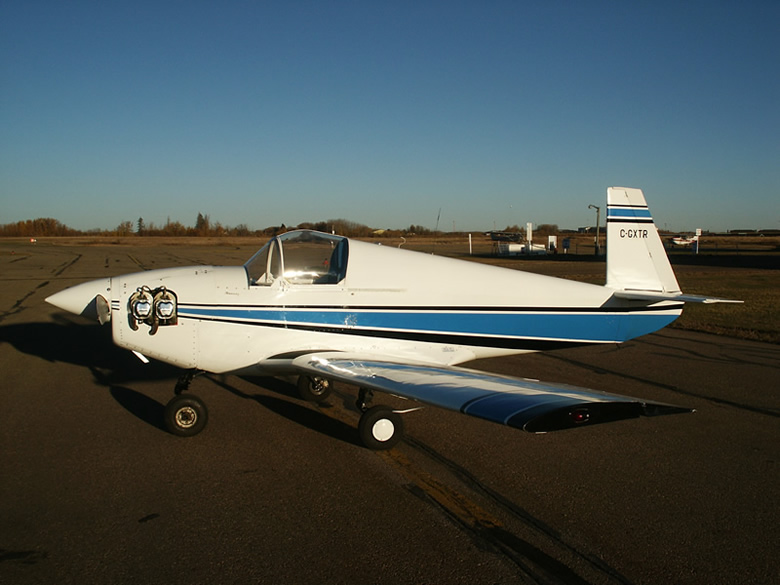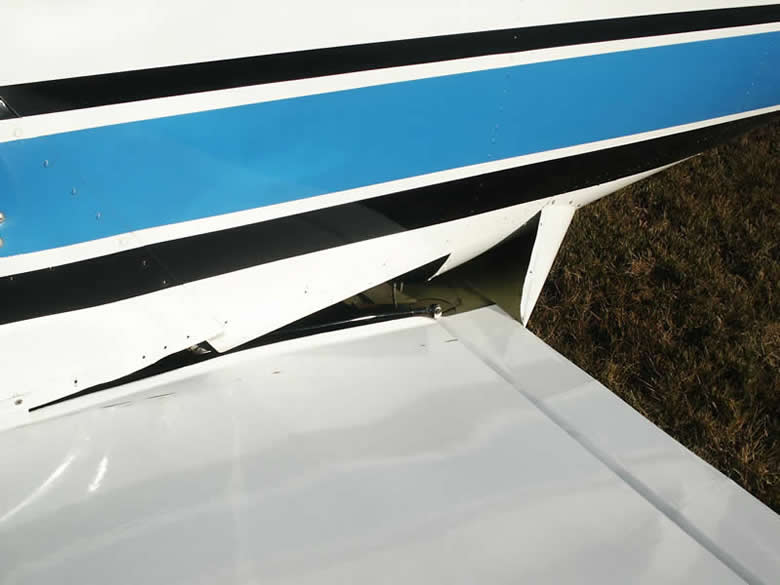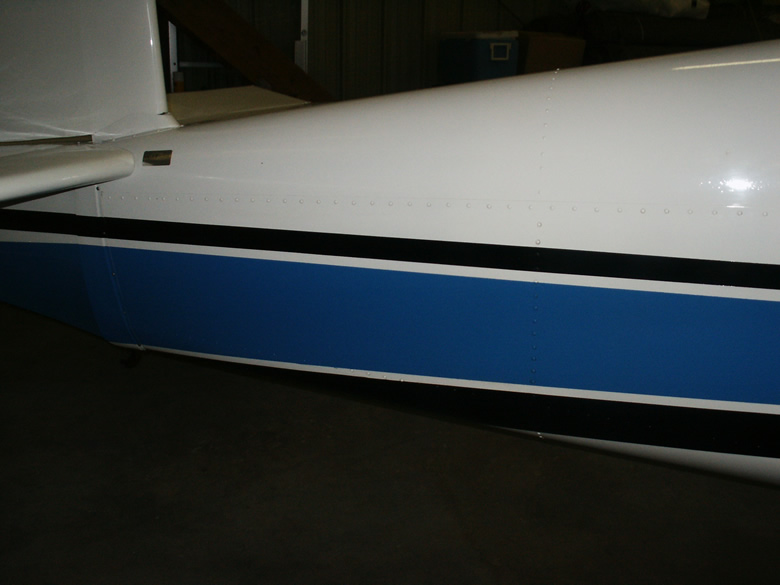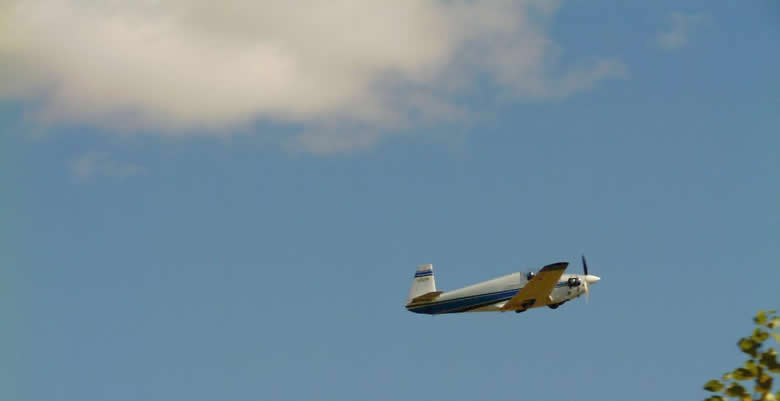HEAVY?
Well... yes, at least as far as MOONEY M-18’s go. X-RAY TANGO ROMEO regularly departs terra firma with a take-off weight exceeding 1000 lbs. (The heaviest certified production model is restricted to 850 lbs while C-GXTR has a licensed gross weight of 1025 lbs.)
METAL?
The entire fuselage is metal construction skinned with aluminum. (Certified production aircraft are wooden aft of the canopy.)

MOONEY M-18X “C-GXTR” STARTED LIFE AS
MOONEY M-18LA SERIAL NO. 142 BUILT IN 1953 (CANADIAN REGISTRATION
CF-LLN)
CF-LLN was purchased in the late 60’s by former WWII Spitfire pilot Carmen Pearson. Based out of Camrose, Alberta; Carmen flew this aircraft only 10 hours before a thorough inspection in 1968 revealed wood rot. Apparently, Lima-Lima-November spent most of its short 15 year life outdoors in the hot and humid climate of Abbotsford, British Columbia (ideal conditions for the early demise of any fine wooden aircraft). The future of this single place Mooney looked grim. A major rebuild could easily cost more than the market value of a used airworthy aircraft.
Enter Alberta aviation guru Denver Jacobson. Denver, a skilled AME, commercial fixed and rotary wing pilot; ended up with the project. Most of Denver’s working career was spent in the aviation industry. He has owned, operated, repaired and rebuilt so many different aircraft, it would be easier to name the types he is unfamiliar with than those of which he is accustomed. This aircraft would eventually be amongst his favourites. The project would take almost 20 years, due in part to Denver’s business commitment (running Camrose’s only aircraft maintenance and repair shop). Heart problems discovered in 1977 led to the loss of pilot privileges, and, without a current medical, his desire to complete the project.
Denver spent the winter of 1980 in the warm climate of California. A
visit with MMOA (Mooney Mite Owner Association) member Edward
Soncrant renewed Denver’s interest. Ed, a former military pilot
who flew F-4U “Corsairs” in the Pacific, was in the process of
installing a Continental 0200 in his Mooney M-18. Denver mentioned his
aspiration of obtaining a US soaring license. In Canada, glider flight requires
a current medical certificate. The FAA saw no reason to keep him grounded. Ed
directed Denver to Mooney M-18 owner and soaring instructor Nancy Batson
Crews.
Like many M-18 pilots of the day, Nancy had logged numerous hours in military aircraft including P-38 “Lightnings”, P-47 “Thunderbolts” and P51 “Mustangs”. When Denver met his potential soaring instructor, Nancy was in the process of running for mayor of California City. Her M-18 was in need of a rebuild and Denver desired once again to take to the air. A deal was struck. Denver would rebuild her single place Mooney and she would get him airborne. Dividing her instructing time with her mayoral duties, she managed to turn out a proficient silent pilot. Denver installed altitude recording equipment in Nancy’s “Schweizer 2-33”, unhooked solo, and climbed to an altitude exceeding 24,000ft. This spectacular performance in an older two place trainer could have been bettered had an oxygen failure not forced Denver to pull out of a thermal and dive for his life. Denver completed the rebuild of Nancy’s M-18 (now on display in the Southern Museum of Flight in Birmingham Alabama) and returned to Canada with his most recent purchase, Nancy’s Schweizer 2-33, in tow.
While persuading local fixed wing pilots to take to soaring, Denver revisited his long awaiting project. Not satisfied with a standard rebuild, Denver had a desire to upgrade this little Mooney with improvements seen on the later designed four place Mooney M-20.
MODIFICATIONS TO C-GXTR INCLUDE:
FUEL
Fuel capacity is increased from 15 to 29 US gallons by the addition of an auxiliary fuel system. Two tanks (one in each wing) are interconnected to an auxiliary holding/filler tank located low in the fuselage behind the pilot’s seat. The cross-fed auxiliary fuel is sent to the carburetor by a Piper low pressure electric fuel pump. The original upper fuselage tank is used for all take-offs and landings. A Piper fuel selector switch, mounted to the right of the pilot’s seat, sorts it all out. Almost all of the fuel contained within both systems is available in level flight. Due to a possible high angle of attack on take-off; or go-around on an aborted landing attempt; it is recommended to observe a minimum of 4 gallons in the main gravity fed tank to ensure adequate head pressure. Two Cessna 150 fuel gauges are located on the instrument panel (one for the main tank and one for auxiliary fuel level display). Consuming a miserly 4.5 US gallons per hour at high cruise, this modified fuel system provides more endurance than most pilots can tolerate. Economy flight permits over 7 hours of level flight time with reserves left in the tank!
WING
Finland birch plywood wraps the entire wing surface, top and bottom. This creates a stiffer, less flexible wing similar to early MOONEY MODEL 20A four place aircraft. A wing root drip rail (hiding behind the intersecting fuselage faring) keeps rainwater from migrating inboard toward the center section. It functions like an eaves trough, channeling water down to drain between the trailing edge of the wing and the leading edge of the flap.
Seaplane grommets line the underside of the wing, placed ahead of the leading edge of the main spar and all lateral wood structures. If water were to penetrate the wing, it would run downhill (toward the trailing edge), stopping at a lateral wood structure, and then drain out the grommets. These grommets provide a final level of insurance to protect the wooden components of C-GXTR. Water penetration of this nature is unlikely however, because the entire wing is jacketed with a layer of fibreglass. This outermost surface is finished with endura epoxy paint.

FUSELAGE
In 1970, Fred Quarles marketed blueprints for the Mooney M-18X, a homebuilt version of the certified M-18. Fred had purchased 16,000 square feet of the original production M-18 drawings and made them available to the public. Denver desired a metal fuselage for his project and says he couldn't have completed this portion of the rebuild without these drawings.
Denver contacted Mooney Aircraft Inc. in Kerrville, Texas to inform them of his project and source out material. The engineering staff were so impressed by his attention to detail, they divulged the name and contact information of the supplier for the MOONEY MODEL 20 longitudinal fuselage stringers. A phone call later and a set of custom stringers for C-GXTR were being fabricated. With blueprints at hand and material in place, a strong, durable metal fuselage was ready for assembly.
The M-18X fuselage plans specified a single metal bulkhead behind the pilot’s seat. Denver installed two bulkheads at this station for additional strength. The rearmost fuselage bulkhead is critical, in that it supports the two upper pivot points used for trim control (the entire tail section attaches to these pivot points). Denver happened to have, at his disposal, a rear bulkhead from a four place MOONEY MODEL 20A. This rear bulkhead was resized to M-18 dimensions and installed. It provides an exceptionally strong attach point for the wooden vertical stabilizer spar (rebuilt to double the original thickness). Any concerns of losing tail feathers in flight are unfounded!

LANDING GEAR
Cessna 150 wheels with 500x5 tires were installed on all three gear legs. The underside wing openings (which store the gear when retracted) were enlarged to accommodate this upgrade. Cleveland hydraulic disc brakes on the mains provide improved stopping performance. The nose wheel mount is reinforced to reduce the bushing wear prevalent on stock M-18’s.
CONTROLS
Flaps are no longer connected to the patented simpli-fly system (whereby flaps lower automatically with nose-up trim position). C-GXTR has an actuator lever, located to the left of the pilot’s seat, for independent manual 3-position flap selection.
ELECTRICAL
Electrical systems were not standard issue on the 284 production
aircraft; however, a few did leave the factory with this option. Many planes
have been upgraded over the years with systems of varying design. C-GXTR
utilizes a lightweight belt driven Toyota 40 amp alternator. A General Motors
offset drive pulley flares out from the propeller shaft flange to provide
adequate belt clearance. A prop extension makes everything fit. A motorcycle
battery (mounted on the firewall) maintains storage for anticipated loads.
Although the installation of an electrical system constitutes a substantial
weight penalty, it does permit the use of modern radio and navigation equipment
(and is essential for electrical fuel pump operation).
ENGINE
The original Lycoming O-145B engine (complete with mount) was replaced by a heavier but more powerful Continental A65-8. Welding for the new mount (and elsewhere as required) was completed by Chuck MacLaren. Over the years, Chuck has welded many components for restored aircraft (Several on display at the Alberta Aviation Museum in Edmonton; AB). Denver speaks highly of Chuck’s welding abilities.

PERFORMANCE
Mooney M-18X C-GXTR ended up with an empty weight of 684 lbs. Kevin Harberg, the aircraft’s current owner, logged the completed plane’s first flight on August 27, 1986 (Denver was still without a valid Canadian medical). On October 12, 1986, with the minimum 25 hours of flight time on the new/rebuilt airframe, Kevin took to the air to satisfy Transport Canada’s Time to Climb Test. Denver filled the fuel tanks to the brim and placed a large steel plate (at least 2” thick) on the seat to increase the light pilot’s overall effective weight. The Continental A65 (installed at the time of flight testing) was an older low compression engine that had been removed from another Mooney M-18. With the take-off weight at 1025 lbs, a climb from 3000 ft density altitude to 4740 ft density altitude was observed at the three minute mark. This climb rate (just under 600 feet per minute) was considered exceptional given the load and the departure altitude. Sea level climb performance with the freshly majored Continental A65-8F (installed in 2002) would undoubtedly be greater. Low take-off weight launches are exhilarating! Although a reduction in rate of climb is detected with full fuel, cruise speed does not change with load. The Cessna 177 prop spinner and the clean finish attribute to good cruise numbers. Level flight Indicated airspeeds of 120 MPH at 5000’ ASL are common at 2150 RPM. 200 km/hr (125 MPH) speeds are used to calculate flight plan times (take-off, climb, and landing included) for the average 1 hour trip. Although complete performance data has not been documented, indicated airspeeds exceeding 135 MPH have been observed with short bursts of full power.
Generous to a fault, Denver offered many pilots the opportunity to fly his finished project. Sadly, Carmen Pearson was not one of them. Carmen passed away before his former pride and joy was re-assembled.
Aviation Hall of Fame inductee Vera Dowling logged 14.4 hours in C-GXTR. Alberta’s first female flight instructor (and former Spitfire pilot) completed 14 flights in this fine aircraft. Vera’s own Mooney M-18 was destroyed in a hangar fire many years earlier.
Reference to military flight time logged by M-18 pilots named in this article is intended to imply a parallel in the aircraft’s fine handling characteristics. Push rod actuators for aileron and elevator control (as found in the M-18) produce an instant response combined with sensitive control feedback, emulating the feel of high performance pursuit planes. A short coupled control stick generates high roll/pitch rates with minimal throw, yet input forces remain low. This aircraft can be flown with only two fingers on the stick. Manoeuvres are only a thought away. No wonder this aircraft won the hearts of so many proficient aviators. The M-18, a single place low wing retractable with a sliding canopy, throttle on the left, center floor mounted control stick, looks and feels like a mini-fighter.
Denver Jacobson eventually regained his pilot’s medical and made 161 flights in C-GXTR before losing flight privileges, again due to heart problems. At the time of this writing, Denver is 83 years young with a steady blood pressure of 120 over 70. He now flies with licensed pilots at his side in his STOL straight tail Cessna 150. He reluctantly sold X-Ray Tango Romeo in 2007 to Kevin Harberg, the first person to fly the restored aircraft 21 years earlier. C-GXTR now has 200 hours since new (Transport Canada calls this aircraft a 1986 Mooney M-18X due to its extensive modifications).

Article and photos by Kevin Harberg
Note: C-GXTR was featured as Mite of the Month in June, 2000.
2009-01-25